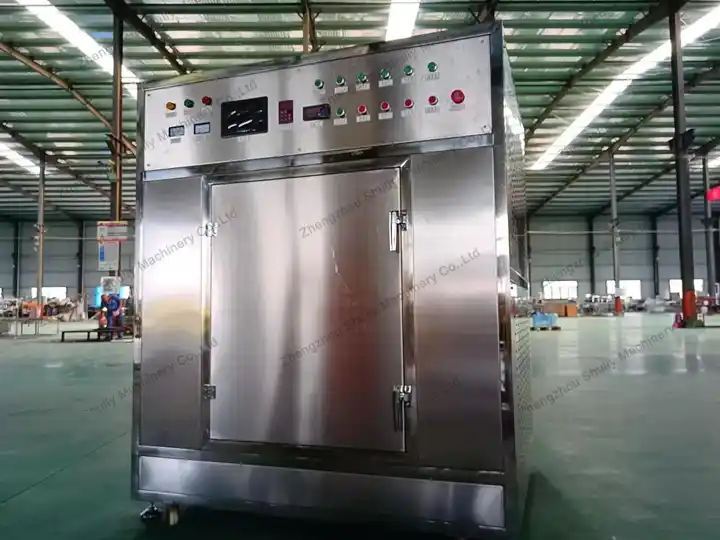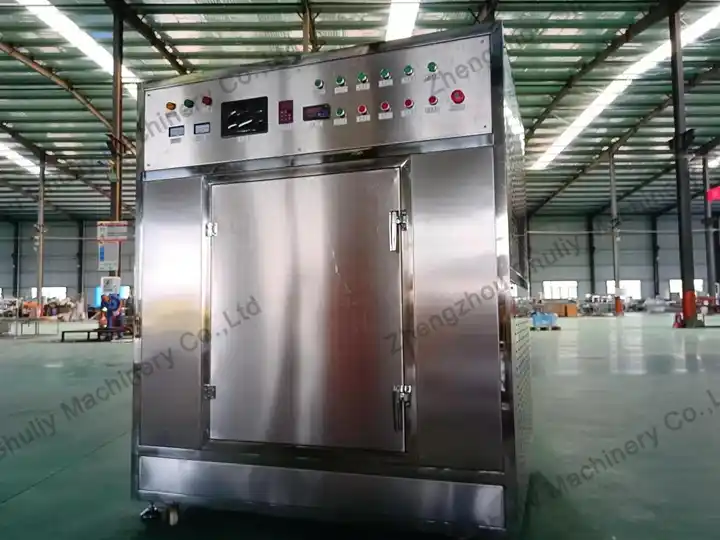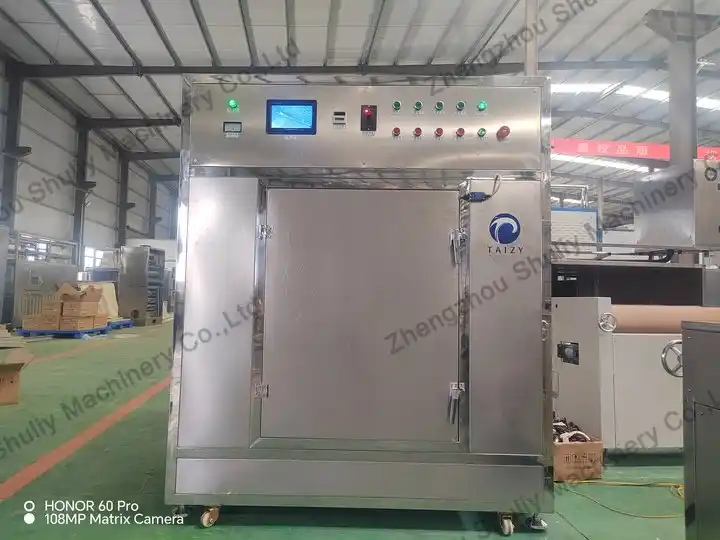
In industries like food, pharmaceuticals, and chemicals, drying equipment is essential. Among all kinds of drying techniques, the microwave dryer has the advantages of high efficiency, low power consumption, accurate temperature control, and can keep the original color and taste.
So, how does it work?
Working Principle of a Microwave Dryer
Different from conventional hot-air or infrared drying, microwave drying uses electromagnetic waves to heat up the interior of the material. The molecules vibrate quickly, producing heat from the inside. This results in an ”overall heating” effect from the inside out, which dries the material efficiently.

மைக்ரோவேவ் ஊடுருவல்: உள்ளும் வெளியும் ஒரே நேரத்தில் வெப்பம் அளிக்கும்
Microwaves generally operate at a frequency of 2450 MHz ± 50 MHz. At this frequency, they can pass through the material’s surface and interact directly with the interior polar molecules, mostly water. This results in the rotation and vibration of the water molecules for a few hundred million times a second, creating internal heat that makes the water evaporate. Advantages over traditional drying methods:
- Much faster heating speed
- Even heating throughout the material, avoiding the issue of “dry outside, wet inside”
- Especially suitable for heat-sensitive or high-moisture products
மின்காந்த வெப்பம்: மைக்ரோவேவ்கள் மூலக்கூறுகளின் இயக்கத்தை தூண்டுகின்றன
The core phenomenon behind microwave drying is dielectric heating. Water molecules, being polar, respond to the alternating electromagnetic field by constantly trying to align with it. This rapid rotation creates intense molecular friction, releasing a large amount of heat internally.
Simplified process
Microwave field → Water molecules vibrate → Internal heat → Moisture evaporates → Drying occurs
நீரின் விலகல் மற்றும் வெளியேற்றம்: விரைவான மற்றும் திறமையான நீரிழிவு
Microwave heating not only vaporizes moisture quickly but also creates internal steam pressure. This pressure pushes the moisture from inside to the outside, where it is expelled via exhaust fans or ventilation systems.
- Compared to hot air drying, microwave drying:
- Drives moisture out naturally, without relying on surface heat gradients
- Enables rapid evaporation with minimal damage to the internal structure
- Retains nutrients and preserves product quality due to lower overall temperature exposure

மைக்ரோவேவு எயர் விலக்கியது vs. பாரம்பரிய ஹாட் ஏர் சுட்டுதல்
| ஒப்ப Comparing Aspect | Microwave Drying | டிப்பிடப்பட்ட வெப்பவளுத்தல் (Traditional Hot Air Drying) |
| Heating Method | Internal direct heating | External heat conduction |
| Heating Efficiency | Fast and uniform | Slow and uneven |
| Energy Consumption | Relatively low | High |
| Temperature Control Accuracy | High (suitable for heat-sensitive materials) | Greatly affected by environment |
| Product Quality | Better retention of nutrients and color | More likely to cause quality loss |
Microwave drying uses internal direct heating, where energy penetrates the material and heats it from the inside out. In contrast, traditional hot air drying relies on external heat transfer, which is slower and often leads to uneven results. Microwave systems provide faster and more uniform heating, making them especially efficient for materials that require precise moisture control.
In terms of energy consumption, microwave drying is more energy-efficient, as it minimizes heat loss and only targets the water molecules in the material. Temperature control is another major advantage—microwave dryers offer high precision, making them ideal for drying heat-sensitive products without compromising their structure or quality.
When it comes to the final product, microwave drying helps preserve nutrients, color, and texture more effectively, while hot air drying may cause thermal degradation, leading to loss of quality. These benefits make microwave drying a preferred choice in industries where quality and efficiency are top priorities.
How to Operate a Microwave Drying Machine?
- Turn on all main power switches and circuit breakers.
- Release the emergency stop button. The control panel screen will light up and clearly display the interior of the drying chamber.
- Press the exhaust fan start button. The white indicator light on the control panel will illuminate, activating both the exhaust and dehumidifying fans. Check if the internal small fans, the exhaust fan, and the dehumidifier fan are operating properly.
- Set the temperature according to the drying process requirements.
- Place the materials evenly on the trays inside the drying chamber.
- Turn on the conveyor switch and adjust the frequency inverter to rotate the trays, ensuring even heating.
- Start the microwave system. The microwave current meter should indicate normal operation, typically showing 2.4A on both channels.
Recommended Latest Model — 8kW Smart Rotary Tray Microwave Dryer (2025 Edition)
மாதிரி: SL-3
மின்சார வழங்கல்: 380V±5% 50Hz±1% 3PHASE
மைக்ரோவேவ் வெளியீட்டு சக்தி: 8kw
Tray களின் எண்ணிக்கை: 3 பிச்
சக்தி: 5-7.5kg/கூட்டம்
மைக்ரோவேவ் அலைநீளம்: 2450MHz±50MHz
மொத்த அளவு: 1400×1200×1600(மிமீ)
மைக்ரோவேவ் வெப்பம் அளிக்கும் பெட்டி: 1000*900*1000(மிமீ)
தரைகளின் விட்டம்: 500மிமீ
Tray வேகம்: 0-40 சுற்றுகள்/நிமிடம்(செயல்படுத்தக்கூடியது)
வெப்பநிலை வரம்பு, துல்லியம்: 0-300℃ (செயல்படுத்தக்கூடியது)
Why We Recommend It?
- சிறந்த தொடு கட்டுப்பாடு: திட்டமிடப்பட்ட அமைப்புகளுடன் எளிதான செயல்பாடு.
- சுழலும் Tray அமைப்பு: எல்லா பொருட்களிலும் ஒரே மாதிரியான வெப்பத்தை உறுதி செய்கிறது.
- நிலையான இரட்டை மைக்ரோவேவ் சேனல்கள்: துல்லியமான மின்சார கண்காணிப்புடன் நிலையான சக்தி வெளியீடு;
- எரிசக்தி சேமிப்பு: குறைந்த மின்சார பயன்பாட்டுடன் உயர் மைக்ரோவேவ் திறன்;
- சிறிய வடிவமைப்பு: ஆய்வகங்கள், ஸ்டுடியோக்கள் அல்லது பைலட் தொழிற்சாலைகளுக்கு ஏற்ற இடத்தைச் சேமிக்கும் கட்டமைப்பு.
